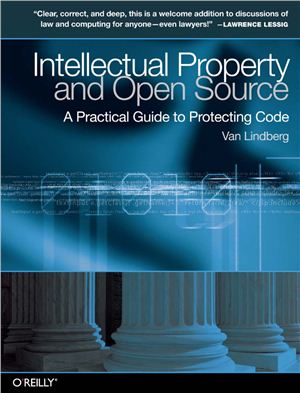Издательство O’Reilly, 2008, -392 pp.
I have a workbench in my garage where I keep some of my woodworking tools. While I am not a great carpenter—actually, I’m a pretty terrible carpenter—I still enjoy building things and working with the wood.
Although I have had my workbench set up for several years, I am always a little bit tentative when I first use a new power tool. I have leaed to respect the fact that tools can be useful, but they can also be difficult or dangerous if not used correctly. To adopt a phrase used with some other tools, it can be too easy to shoot yourself in the foot.
This book is about a tool that we use called intellectual property—IP for short. We use IP to allocate value and create incentives in society. Just like many other powerful tools, IP can be very useful, but it can also be difficult to work with. You can (easily!) shoot yourself in the foot with intellectual property if you don’t understand how and why this tool works.
Unfortunately, there are few topics quite as misunderstood as intellectual property. Take a detour through the comments section of almost any recent Slashdot discussion. Many contributors begin their comments with, IANAL, but. (I am not a lawyer, but.) and then attempt to describe a legal principle, often incorrectly.
Part of my job each day is to work as a translator—translating from lawyer to engineer and back. For lawyers, I describe the interactions between computers, networks, and code. For engineers, I describe how to work with the legal system. My goal for this book is to raise the level of understanding and discussion about intellectual property and software. If we understand the function and rationales behind IP law, we can work with IP more easily, discuss it more fluently, and work together to improve it where necessary.
The Economic and Legal Foundations of Intellectual Property
The Patent Document
The Patent System
Copyright
Trademarks
Trade Secrets
The Economic and Legal Foundations of Open Source Software
So I Have an Idea.
Choosing a License
Accepting Patches and Contributions
Working With the GPL
Reverse Engineering
Incorporating as a Non-Profit
A Sample Proprietary Information Agreement (PIA)
B Open Source License List
C Free Software License List
D Fedora License List and GPL Compatibility
E Public Domain Declaration
F The Simplified BSD License
G The Apache License, Version 2.0
H The Mozilla Public License, Version 1.1
I The GNU Lesser General Public License, Version 2.1.
J The GNU Lesser General Public License, Version 3.
K The GNU General Public License, Version 2, June 1991.
L The GNU General Public License, Version 3, June 2007.
M The Open Software License, Version 3.0
I have a workbench in my garage where I keep some of my woodworking tools. While I am not a great carpenter—actually, I’m a pretty terrible carpenter—I still enjoy building things and working with the wood.
Although I have had my workbench set up for several years, I am always a little bit tentative when I first use a new power tool. I have leaed to respect the fact that tools can be useful, but they can also be difficult or dangerous if not used correctly. To adopt a phrase used with some other tools, it can be too easy to shoot yourself in the foot.
This book is about a tool that we use called intellectual property—IP for short. We use IP to allocate value and create incentives in society. Just like many other powerful tools, IP can be very useful, but it can also be difficult to work with. You can (easily!) shoot yourself in the foot with intellectual property if you don’t understand how and why this tool works.
Unfortunately, there are few topics quite as misunderstood as intellectual property. Take a detour through the comments section of almost any recent Slashdot discussion. Many contributors begin their comments with, IANAL, but. (I am not a lawyer, but.) and then attempt to describe a legal principle, often incorrectly.
Part of my job each day is to work as a translator—translating from lawyer to engineer and back. For lawyers, I describe the interactions between computers, networks, and code. For engineers, I describe how to work with the legal system. My goal for this book is to raise the level of understanding and discussion about intellectual property and software. If we understand the function and rationales behind IP law, we can work with IP more easily, discuss it more fluently, and work together to improve it where necessary.
The Economic and Legal Foundations of Intellectual Property
The Patent Document
The Patent System
Copyright
Trademarks
Trade Secrets
The Economic and Legal Foundations of Open Source Software
So I Have an Idea.
Choosing a License
Accepting Patches and Contributions
Working With the GPL
Reverse Engineering
Incorporating as a Non-Profit
A Sample Proprietary Information Agreement (PIA)
B Open Source License List
C Free Software License List
D Fedora License List and GPL Compatibility
E Public Domain Declaration
F The Simplified BSD License
G The Apache License, Version 2.0
H The Mozilla Public License, Version 1.1
I The GNU Lesser General Public License, Version 2.1.
J The GNU Lesser General Public License, Version 3.
K The GNU General Public License, Version 2, June 1991.
L The GNU General Public License, Version 3, June 2007.
M The Open Software License, Version 3.0

